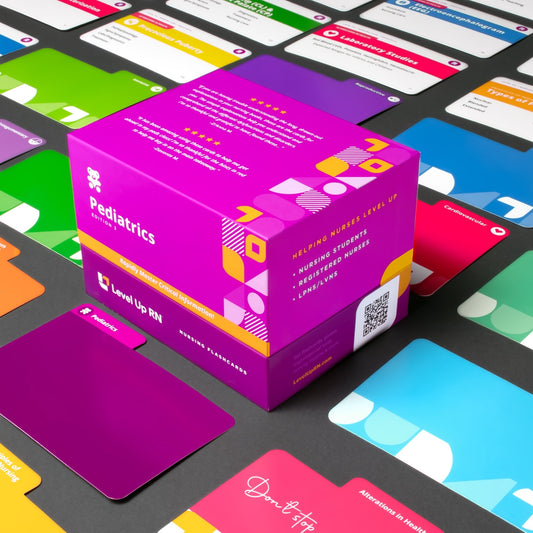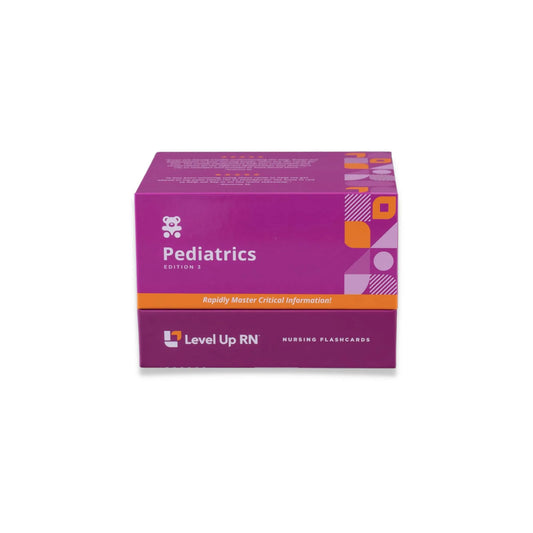Peds, part 27: Cardiovascular Disorders - Kawasaki Disease
Kawasaki Disease. The pathophysiology, phases of Kawasaki disease, symptoms associated with each phase, abnormal labs present with Kawasaki disease, diagnostic criteria, treatment, nursing care, and family teaching for the disorder.
Full Transcript: Peds, part 27: Cardiovascular Disorders - Kawasaki Disease
Full Transcript: Peds, part 27: Cardiovascular Disorders - Kawasaki Disease
Hi, I'm Cathy with Level Up RN. In this video, we are going to talk about Kawasaki disease. And if you have our Level Up RN pediatric nursing flashcards, pull those out so you can follow along with me. Also, at the end of this video, I'm going to give you guys a little quiz to test your knowledge of some of the key points I'll be covering this video. So definitely stay tuned for that.
Kawasaki disease is the systemic inflammation of the blood vessels in the body, so vasculitis. The cause of this disorder is not known. However, it is possibly due to an exaggerated immune response to an infection in a susceptible child. So there are three phases in Kawasaki disease. We have the acute phase, the subacute phase, and the convalescent phase. So throughout this video and throughout our flashcards that deal with Kawasaki disease, I use the imagery of a red Kawasaki motorcycle to help you remember some of the signs and symptoms and other things with Kawasaki disease. Well, it's been brought to my attention that Kawasaki motorcycles are not red. They're never red, apparently, which shows you how much I know about motorcycles. I guess they're green. But for the sake of remembering Kawasaki Disease manifestations, we are going to live in our little make-believe world where Kawasaki motorcycles are red. So hopefully that will help you. And I apologize if you have a Kawasaki motorcycle and you're like, okay, girl, it's green. I do know that now.
So let's talk about the signs and symptoms during the acute phase of Kawasaki disease. This includes a high fever. So this fever will be over 102 degrees Fahrenheit. It will last for one to two weeks, and it will be unresponsive to antipyretics. Then we will have various areas of redness or erythema on the body. So we will have red eyes without drainage; we will have chapped and cracked lips that are also red. The oral mucosal membrane will be red, and then the patient's palms and their soles will be red. In addition, the patient will have arthritis as well as enlarged cervical or neck lymph nodes and possibly cardiac symptoms as well, such as dysrhythmias and myocarditis. So again, that red Kawasaki motorcycle is to help you to remember those red eyes, red mouth, red palms, and red soles.
Okay, so then we move into our subacute phase. So during this time, the fever resolves. However, the patient has arthritis present as well as peeling skin around the nails, palms, or soles. So if you think about wiping out on your red Kawasaki motorcycle, you may end up with peeling skin from that accident.
And then finally, we have the convalescent phase. This is where there are no clinical manifestations. However, abnormal labs may be present in the child. Abnormal labs that may be present with Kawasaki disease include an elevation in CRP and ESR, which are two labs that will be elevated in the presence of inflammation. In addition, the patient's albumin levels will be decreased. Diagnosis is done based on a set of criteria. So if the patient has a fever for over five days and four of the five symptoms that I'm going to go over next, then that would be indicative of Kawasaki disease.
So a good way to remember these symptoms is to think about cream, C-R-E-A-M, and think about your motorcycle getting creamed in an accident. So the C stands for conjunctivitis, so redness of the eyes. The R stands for rash. The E stands for extremity changes, which includes redness of the hands and feet during the acute phase and peeling skin on the hands and feet during the sub-acute phase, and then the A stands for adenopathy. This is where we have enlarged lymph nodes, particularly of the neck. And then M stands for mucosal changes. This is where we have red lips that are cracked and red mucous membranes as well as a strawberry tongue. So again, the patient would have Kawasaki disease if they have four out of the five of these symptoms plus that fever for more than five days.
Treatment of Kawasaki disease includes intravenous immunoglobulin, so IVIG, as well as high dose aspirin. And this is one of the few conditions where aspirin is okay to be given to the child. So normally we do not want to give aspirin to a child for viruses or fever or anything for the fear of Reye's syndrome. But with Kawasaki disease, that is the preferred medication to give the child along with the IVIG.
In terms of nursing care, we're going to want to closely monitor our patient's cardiac function because of the carditis that is associated with Kawasaki disease. We're also going to monitor their daily weights and eyes and nose. And then an important family teaching point we need to provide is that live immunizations should not be administered to the child for eleven months. So this includes immunizations such as MMR and Varicella.
All right, it's time for a quiz. Are you guys ready? First question. Red lips, tongues, palms, and soles are present during what phase of Kawasaki disease? The answer is the acute phase.
Question number two. What two key medications are used to treat Kawasaki disease? The answer is IVIG and aspirin.
Question number three. For a child with Kawasaki disease, what teaching do you need to provide the child's family regarding vaccinations? The answer is no live vaccines for eleven months.
All right, that's it for this video. In my next video, we are going to talk about anemia, so definitely stay tuned for that.
Kawa-- sorry.



1 comment
I just googled it… there are FOR SURE red Kawasaki motorcycles!! PS: thank you for helping me pass med surg!! Now time for Peds :)